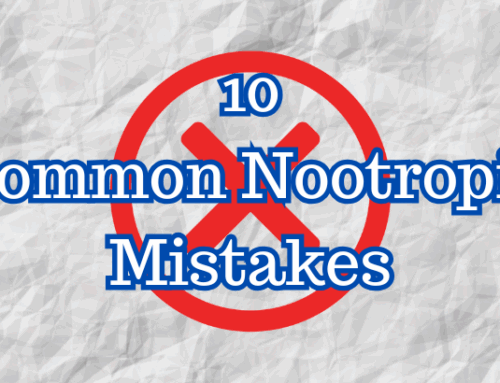As you may have noticed, a lot of nootropics end in the suffix -etam. Some well-known nootropics that end in -etam include piracetam, aniracetam, and phenylpiracetam. But what does that suffix mean?
It means they are all racetams. But what is a racetam? That's the question we're going to answer in this article.
What Is A Racetam?
The racetams are a class of chemically-similar substances, many of which are nootropics. What the racetams have in common is that they all share a pyrrolidone nucleus.1 And they all share the suffix -etam.
It is very common in the world of drugs to group similar compounds together and give them a common suffix. Take benzodiazepines (or benzos for short), for example. Common benzos you may recognize include diazepam (Valium), lorazepam (Ativan), clonazepam (Klonopin), and alprazolam (Xanax). Notice how they all end in either -pam or -lam?
Benzos are most certainly not considered nootropics. If anything they decrease mental performance and can be highly addictive: two things nootropics definitely don't do. But they are one of many examples of a class of drugs that share a common suffix. Besides the racetams, another class of nootropics that share the same suffix are eugeroics (wakefulness-promoting drugs). These include modafinil, armodafinil, adrafinil, and fluromodafinil. As you can see, they all end with -afinil.
Not all racetams are nootropics, but many are. While the racetams are chemically similar, they don't all work the same way. Just because two drugs are similar chemically doesn't mean they will have the same effect on the body and brain. However, it is thought that many of the racetams' nootropic effects come from its ability to influence glutamate and cholinergic receptors.2 Glutamate and acetylcholine are neurotransmitters known to play a crucial role in learning and memory.
But not all racetams affect these receptors in the same way. Piracetam, for example, is an allosteric modulator of the AMPA receptor, a subtype of glutamate receptors.3 And the racetams can affect a variety of other neurotransmitters and their receptors besides glutamate and choline, but it depends on the substance. For example, aniracetam has been found to affect the neurotransmitters dopamine and serotonin in certain parts of the brain.4
The racetams have been around for quite a while. Now let's take a look at their history.
The History Of The Racetams
The first racetam to ever be created was piracetam – but it certainly wasn't the last. In 1964, a Romanian chemist named Corneliu Giurgea first synthesized piracetam by altering a GABA molecule.5

Dr. Giurgea coined the term “nootropic” in the 1960s.
Dr. Giurgea was also the person who coined the term “nootropic.”6 He noticed that piracetam enhanced cognition without causing any side effects and needed a term to describe it. That makes piracetam not only the first racetam but also the first nootropic.
After the creation of piracetam in 1964, a number of other racetams were created throughout the 60s and 70s by various drug companies. Aniracetam and pramiracetam, two popular nootropics, were first created in the 1970s by the drug companies Hoffmann-La Roche and Parke-Davis, respectively.78
In the decades following piracetam's creation, the Russians took an interest in it and other cognition-enhancing drugs. They created a number of racetams, one of which was phenylpiracetam. In 1983, the Russian Academy of Science developed phenylpiracetam to help Soviet Cosmonauts to deal with the stresses of being in space.9 They found it to have a number of stress-reducing and brain-boosting effects.
Phenylpiracetam was available in Russia as a prescription medication under the trade name Phenotropil until 2017.10 For years, it was used to treat a variety of conditions. And phenylpiracetam isn't the only racetam that is or has been used as a prescription drug.
In several European countries, pramiracetam (under the trade name Pramistar) is used by doctors to treat memory and attention problems in the elderly.11 Aniracetam is also used as a prescription medication in several European countries sold under the trade names Draganon, Sarpul, Memodrin, Referan, and Ampamet.12 And piracetam is a prescription drug in England and in Japan.13 Those are just a few examples of racetams that are prescription drugs overseas, but there are others.
In recent years, a number of racetams have become popular in the United States and in other countries for their nootropic benefits. In the U.S., most racetams are not prescription drugs and can be purchased online. Over the last decade, interest in nootropics has grown immensely. And since there are several racetams known to improve cognition without causing any serious side effects, they are among the most popular classes of smart drugs being used today.
Now let's take a look at some nootropic racetams. We won't list all of them nor will we go into a lot of detail. These are just a few of the most popular nootropic racetams.
Nootropic Racetams
There are a number of racetams that have powerful brain-boosting effects. Here are some of the most popular ones being used for their nootropic benefits.
Piracetam

- Improved learning
- Memory enhancement
- Greater focus
- Increased Motivation
You can learn more here: Piracetam – The First Nootropic.
Aniracetam

- Reduced anxiety
- Improved memory and learning
- Increased focus
- Improved mood
You can learn more here: Aniracetam For Anxiety and Focus.
Pramiracetam

- Increased focus
- Improved working and long-term memory
- Enhanced learning
You can learn more here: Pramiracetam – A Powerful Cognitive Enhancer.
Phenylpiracetam

- Increased focus
- Improved mood
- Improved memory
- Increased motivation
- Improved physical performance
You can learn more here: Phenylpiracetam – The Best Adderall Alternative.
Other Nootropic Racetams
Those are four of the safest and most popular racetams being used as nootropics, but there are several others. Some other nootropic racetams include:
- Coluracetam
- Fasoracetam
- Nefiracetam
- Oxiracetam
- Sunifiram
- Unifiram
To learn more about the various nootropic racetams, check out this article: The Best Racetams – A Comparison.
Conclusion
 Now you should have a good idea of what the racetams are, how they generally work, and some examples of popular ones being used around the world today. Racetams like piracetam, aniracetam, and pramiracetam are among the most popular nootropics because of their safety and effectiveness.
Now you should have a good idea of what the racetams are, how they generally work, and some examples of popular ones being used around the world today. Racetams like piracetam, aniracetam, and pramiracetam are among the most popular nootropics because of their safety and effectiveness.
New racetams are being discovered and tested all the time. Some of them, like sunifiram and unifiram for example, have shown a lot of potential as nootropics.15 Researchers from around the world continue to carry out the work that Dr. Giurgea started over 50 years ago. And as interest in nootropics continues to grow, this research shouldn't slow down any time soon.
Have you tried one or more racetams? Do you have a favorite? Please leave your answer in the comments section below.
To learn more about nootropics, sign up for the Nootropics Zone newsletter. You'll get the free gift, The Ultimate Nootropics Quick Reference Guide.
References
1Loscher, W., & Richter, A. (2000). Piracetam and levetiracetam, two pyrrolidone derivatives, exert antidystonic activity in a hamster model of paroxysmal dystonia. European Journal of Pharmacology, 391(3):251-4.
2Copani, A., Genazzani, A., Aleppo, G., Casabona, G., et al. (1992). Nootropic drugs positively modulate α-amino-3-hydroxy-5-methy-4-isoxazolepropionic acid-sensitive glutamate receptors in neuronal cultures. Journal of Neurochemistry, 58(4):1199-1204.
3Ahmed, A., & Oswald, R. (2010). Piracetam defines a new binding site for allosteric modulators of alpha-amino-3-hydroxy-5-methyl-4-isoxazole-propionic acid (AMPA) receptors. Journal of Medical Chemistry, 53(5):2197-2203.
4Shirane, M., & Nakamura, K. (2001). Aniracetam enhances cortical dopamine and serotonin release via cholinergic and glutamatergic mechanisms in SHRSP. Brain Research, 916(1-2):211-21.
5Giurgea, C., Greindl, M., & Preat, S. (1983). Nootropic drugs and aging. Acta Psychiatrica Belgica, 83(4):349-58.
6Shorvon, S. (2001). Pyrrolidone derivatives. The Lancet, 358(9296):1885-92.
7Aniracetam. (n.d.). Wikipedia. Retrieved July 31, 2020 from https://en.wikipedia.org/wiki/Aniracetam
8Pramiracetam. (n.d.). Wikipedia. Retrieved July 31, 2020 from https://en.wikipedia.org/wiki/Pramiracetam
9Fedotova, O. (2004). Фенотропил: закономерное лидерство. РЕМЕДИУМ, 36.
10Phenylpiracetam. (n.d.). Wikipedia. Retrieved July 31, 2020 from https://en.wikipedia.org/wiki/Phenylpiracetam
11Pramiracetam. (n.d.). Drugs.com. Retrieved July 31, 2020 from https://www.drugs.com/international/pramiracetam.html
12Malykh, A., & Sadaie, M. (2010). Piracetam and piracetam-like drugs: from basic science to novel clinical applications to CNS disorders. Drugs, 70(3):287-312.
13UCB's piracetam approved in Japan. (1999, Nov. 25). The Pharma Letter. Retrieved July 31, 2020 from https://www.thepharmaletter.com/article/ucb-s-piracetam-approved-in-japan
14Bobkov, I., Morozov, I., Glozman, O., Nerobkova, L., & Zhmurenko, L. (1983). Pharmacological characteristics of a new phenyl analog of piracetam – 4-phenylpiracetam. Biulleten Eksperimental'noi Biologii I Meditsiny, 95(4):50-3.
15Gualtieri, F. (2015). Unifi nootropics from the lab to the web: a story of academic (and industrial) shortcomings. Journal of Enzyme Inhibition and Medicinal Chemistry, 31(2):187-94.
[Originally published August 20, 2014. Updated July 31, 2020.]







Would like to know more about it